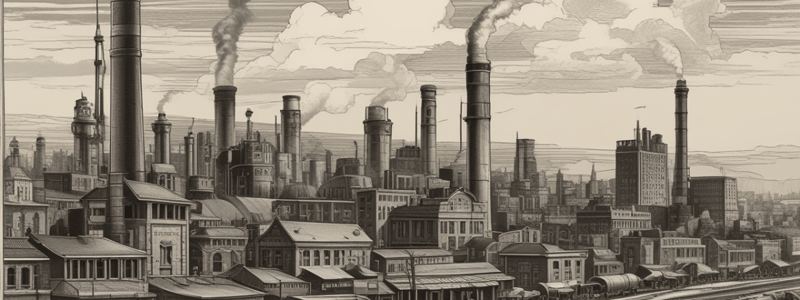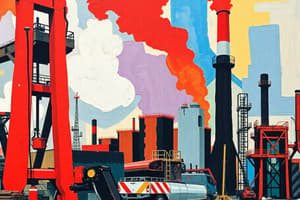Podcast
Questions and Answers
What was the primary impact of prohibition on certain industries in the 1920s?
What was the primary impact of prohibition on certain industries in the 1920s?
- It led to the expansion of the cotton and textile industries.
- It led to increased demand for agricultural products used in alcoholic beverages.
- It had no significant impact on agricultural industries.
- It resulted in a decline in demand for agricultural products used in alcoholic beverages. (correct)
What was the primary impact of changing women's fashions on the textile industry in the 1920s?
What was the primary impact of changing women's fashions on the textile industry in the 1920s?
- It resulted in a decline in demand for cotton and textiles. (correct)
- It led to the expansion of the shipbuilding industry.
- It led to increased demand for cotton and textiles.
- It had no significant impact on the textile industry.
What was the primary impact on workers in declining industries in the 1920s?
What was the primary impact on workers in declining industries in the 1920s?
- They experienced increases in wages and job stability.
- They were able to easily find work in new, emerging industries.
- They faced drops in wages, job instability, and unemployment. (correct)
- They were able to successfully unionize and go on strikes to protect their jobs.
What was the primary cause of the decline in the shipbuilding industry in the 1920s?
What was the primary cause of the decline in the shipbuilding industry in the 1920s?
What was the primary cause of the decline in the coal industry in the 1920s?
What was the primary cause of the decline in the coal industry in the 1920s?
Which of the following industries experienced a decline in the 1920s due to changes in the economy?
Which of the following industries experienced a decline in the 1920s due to changes in the economy?
What was a primary reason for the decline of the farming industry in the 1920s?
What was a primary reason for the decline of the farming industry in the 1920s?
Which industry experienced a decline due to the rise of new technologies in the 1920s?
Which industry experienced a decline due to the rise of new technologies in the 1920s?
What caused the textile industry to struggle in the 1920s?
What caused the textile industry to struggle in the 1920s?
Which industry's decline was related to the increasing use of electricity in homes and businesses?
Which industry's decline was related to the increasing use of electricity in homes and businesses?
Study Notes
Effects of Declining Industries
- Prohibition led to a decline in demand for hops, apples, grapes, and barley, affecting farmers who grew these crops.
- Changing women's fashions, such as shorter skirts, reduced the demand for cotton and textiles.
- Declining industries resulted in lower wages, job loss, and instability for workers.
- Strikes became more common and violent.
- Workers in declining industries often lacked the skills and training to find work in new sectors.
Shipbuilding Industry Decline
- The end of World War I led to a decrease in demand for ships, causing the shipbuilding industry to struggle.
Coal Industry Decline
- Declining demand for coal was caused by the rise of electricity from hydroelectric dams, reducing the need for coal for heating and power.
- The increasing use of oil and gas as fuel also contributed to the decline of the coal industry.
- Improved technology allowed for more efficient burning of coal, reducing the amount needed.
- The decline of the railways meant less coal was needed to power steam engines.
Railway Industry Decline
- The construction of roads and the rise of cars and lorries led to a decline in the use of railways for passenger and freight transport.
Textiles Industry Decline
- The introduction of synthetic textiles like rayon and nylon replaced cotton, contributing to the decline of the textiles industry.
- New fashions, such as shorter skirts, reduced the demand for textiles.
Farming Industry Decline
- The end of World War I led to a surplus of food and a drop in prices, causing economic problems for farmers.
- Many farmers had gone into debt to expand their farms during the war and struggled to pay it back.
Replaced Industries
- The rise of the motor car and road construction led to a decline in the use of railways.
- Synthetic fabrics like nylon and rayon replaced cotton, affecting cotton farmers and textile workers.
- The increased use of electricity from hydroelectric dams reduced the need for coal.
Studying That Suits You
Use AI to generate personalized quizzes and flashcards to suit your learning preferences.
Description
Learn about the industries that declined in America during the 1920s, such as shipbuilding, coal mining, railways, farming, and textiles. Discover how the end of the First World War contributed to the decline of some industries that had prospered during the war.




